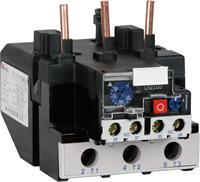Thermal overload relays are protective devices used for overload protection of electric motors ,contactors or other electrical equipment and electrical circuits.
In the actual operation of the motor, such as dragging the production machine to work, if the machine is abnormal or the circuit is abnormal, the motor encounters overload, the motor speed decreases, the current in the winding will increase, and the winding temperature of the motor will be increased. Raise. If the overload current is not large and the overload time is short, the motor winding does not exceed the allowable temperature rise. This overload is allowed. However, if the overload time is long and the overload current is large, the temperature rise of the motor winding will exceed the allowable value, which will cause the motor winding to age, shorten the service life of the motor, and even burn the motor winding in severe cases. Therefore, this overload is unacceptable to the motor. The thermal relay is a protection device that uses the principle of the thermal effect of the current to cut off the motor circuit in the event of an overload that the motor cannot withstand, providing overload protection for the motor.
The most common over current protective device is the thermal overload relay associated with motor starting contactors.
Bimetallic type overload relays open the circuit when heat is sufficient to cause a bimetallic element to bend out of shape, thus parting a set of contacts. Bimetallic relays are normally used on automatic reset, although they can be used either manually or automatically.
Standard, slow, and quick-trip (fast) relays are available. Standard units should be used for motor starting times up to about 7 seconds. Slow units should be used for motor starting times in the 8-12 second range, and fast units should be used on special-purpose motors, such as hermetically sealed and submersible pump motors which have very fast starting times
Points for attention in the selection of thermal relays
1, type selection
Under normal circumstances, a two-phase structure of the thermal relay can be selected, but when the balance of the three-phase voltage is poor, the working environment is bad or the motor is unattended, a three-phase thermal relay should be selected. For motors with delta connections, thermal relays with phase-break protection should be used.
2, thermal relay rated current selection
The rated current of the thermal relay should be greater than the rated current of the motor. Then select the model of the thermal relay based on the rated current.
3. Selection and setting of rated current of thermal components
The rated current of the thermal element should be slightly larger than the rated current of the motor. When the motor starting current is 6 times of its rated current and the starting time does not exceed 5S, the setting current of the hot parts is adjusted to be equal to the rated current of the motor; when the starting time of the motor is long, the impact load is dragged or not allowed to stop. When the thermal component setting current is adjusted to 1.1 to 1.15 times the rated current of the motor.
Installation direction of thermal relay
The installation direction of the thermal relay is easily overlooked. The thermal relay is a current that generates heat through the heating element and pushes the bimetal action. There are three ways to transfer heat, convection, radiation and conduction. The convection is directional and the heat is transferred from the bottom to the top. When placed, if the heating element is under the bimetal, the bimetal heats up quickly and the action time is short; if the heating element is next to the bimetal, the bimetal heats up slowly and the thermal relay takes a long time to operate. . When the thermal relay is installed with other electrical appliances, it should be installed under the electrical appliance and away from other electrical appliances by 50mm or more to protect it from the heat generated by other electrical appliances. The installation direction of the thermal relay should be carried out in accordance with the product specification to ensure that the thermal relay is consistent in its performance.
Adjustment of thermal relay
Before putting into use, the setting current of the thermal relay must be adjusted to ensure that the setting current of the thermal relay matches the rated current of the protected motor.
For example, for a 10kW, 380V motor, the rated current is 19.9A, JR20-25 type thermal relay can be used, the heating element setting current is 17~21~25A, first set at 21A according to the general situation, if it is found that it often moves in advance, The temperature rise of the motor is not high, the setting current can be changed to 25A to continue observation; if the motor temperature rises at 21A, and the thermal relay lags, it can be observed at 17A to get the best fit.
Post time: Aug-13-2018

